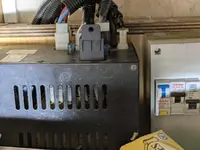Sorry about this, but I have no manuals for this, and the previous owner couldn’t help.
I have this fuse box and a controller (with 1 relay and 2 fuses).
The van has an original set of circuits (e.g. some lights, fridge) and a previous owner added some 3-pin plugs & fluorescent lights.
There is an inverter (with an on-off switch) adjacent to the leisure battery, and there is a solar panel on the roof (with a control panel I haven’t even looked at yet).
I have replaced the old leisure battery with a brand new, fully charged one.
All the electrical items/sockets work when I plug in the external supply.
When I unplug this external supply, the original circuit works, but the 3-pin circuit does not.
Given this (and the photo attached), can anyone tell me
Many thanks

I have this fuse box and a controller (with 1 relay and 2 fuses).
The van has an original set of circuits (e.g. some lights, fridge) and a previous owner added some 3-pin plugs & fluorescent lights.
There is an inverter (with an on-off switch) adjacent to the leisure battery, and there is a solar panel on the roof (with a control panel I haven’t even looked at yet).
I have replaced the old leisure battery with a brand new, fully charged one.
All the electrical items/sockets work when I plug in the external supply.
When I unplug this external supply, the original circuit works, but the 3-pin circuit does not.
Given this (and the photo attached), can anyone tell me
- what each of the flip switches does on the fuse box
- what is the relay for
- is there a way to find out if the 3-pin circuit should work running from the battery
- what is the inverter for?
Many thanks


